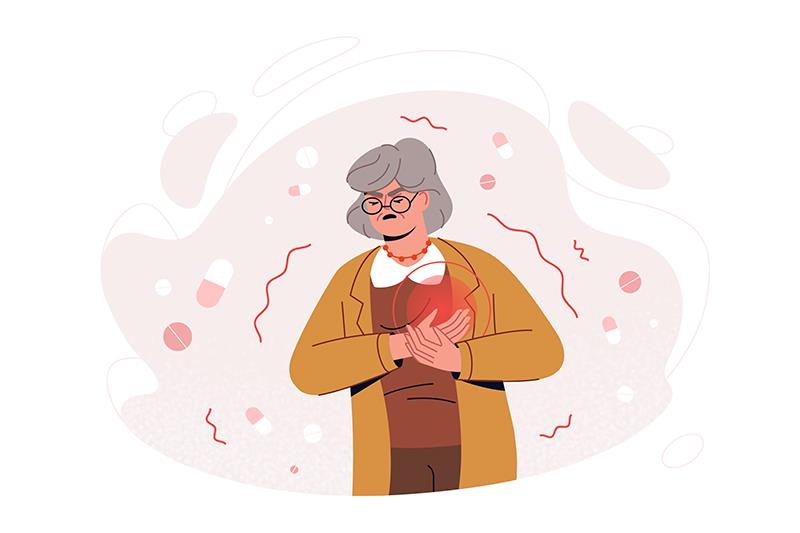Menopausal hormone therapy poses cardiac risk for older women





Hormone therapy for vasomotor symptoms (VMS) appears to raise the risk of atherosclerotic cardiovascular disease (ASCVD) for women exposed to the treatment later in life, according to a secondary analysis of two Women’s Health Initiative (WHI) trials.
At age 70 years and older, exposure to conjugated equine estrogen (CEE; 0.625 mg per day) increased the risk of ASCVD by nearly twofold (hazard ratio [HR], 1.95, 95 percent confidence interval [CI], 1.06–3.59; 217 excess events per 10,000 person-years), while exposure to the combination of CEE plus medroxyprogesterone acetate (MPA; 2.5 mg per day) was associated a more than threefold risk increase (HR, 3.22, 95 percent CI, 1.36–7.63; 382 excess events per 10,000 person-years). [JAMA Intern Med 2025;doi:10.1001/jamainternmed.2025.4510]
At age 60 to 69 years, there was no clear signal of harm seen with exposure to either CEE alone (HR, 1.31, 95 percent CI, 0.90–1.90; 74 excess events per 10,000 person-years) or CEE plus MPA (HR, 0.84, 95 percent CI, 0.51–1.39; 40 fewer events per 10,000 person-years).
At age 50–59 years, exposure to hormone therapy had a null effect on the risk of ASCVD. This was true for both CEE alone (HR, 0.85, 95 percent CI, 0.53–1.35; 13 fewer events per 10,000 person-years) and CEE plus MPA (HR, 0.84, 95 percent CI, 0.44–1.57; 6 fewer events per 10,000 person-years).
“Hormone therapy is most commonly prescribed for VMS during the early postmenopausal years, but bothersome VMS and any VMS may persist into older ages in 10 percent and 25 percent of women, respectively,” noted first study author Dr Jacques Rossouw from the National Heart, Lung, and Blood Institute in Bethesda, Maryland, US, and colleagues. [Menopause 2011;18:603-610; Arch Intern Med 2008;168:840-846]
“Our findings support current clinical guidelines, which generally recommend initiation of hormone therapy for VMS in women age 50–59 years (or within 10 years of menopause). Some guidelines also recognize continuation of hormone therapy use in healthy older women via individualized shared decision-making, while others advise avoidance of hormone therapy in older women,” they said. [Menopause 2022;29:767-794; Obstet Gynecol 2014;123:202-216; J Clin Endocrinol Metab 2015;100:3975-4011; Circulation 2023;147:597-610]
Rossouw and colleagues emphasized the need to exercise a degree of caution about initiating hormone therapy for treating VMS in women age 60–69 years. In women 70 years and older, however, the substantial attributable risk for ASCVD is too high to justify the use of hormone therapy, they added.
“Newer US FDA–approved nonhormonal therapies for VMS, such as fezolinetant, are now on the market and are alternatives to hormone therapy for this indication, but fezolinetant has not been tested in women older than 65 years,” the authors said. [Lancet 2023;401:1091-1102]
WHI trials
Of the WHI trials analysed, one tested CEEs vs placebo in women with hysterectomy (n=10,739), and the other tested CEE plus MPA vs placebo in women with an intact uterus (n=16,608). The mean age of the overall population was 63.4 years. ASCVD was defined as a composite of nonfatal myocardial infarction, hospitalization for angina, coronary revascularization, ischaemic stroke, peripheral arterial disease, carotid artery disease, or CVD death. The median follow-up was 7.2 years in the CEE alone trial and 5.6 years in the CEE plus MPA trial.
Moderate or severe VMS were present at baseline in 27.6 percent of women age 50–59 years, 14.7 percent of those age 60–69 years, and 8.7 percent of those 70 years and older in the CEE alone trial; and in 22.4 percent, 8.7 percent, and 4.8 percent, respectively, in the CEE plus MPA trial.
CEE alone alleviated VMS by 41 percent across all age groups (overall relative risk [RR], 0.59, 95 percent CI, 0.53–0.66). However, the efficacy of CEE plus MPA against VMS was attenuated with age (50–59 years: RR, 0.41, 95 percent CI, 0.35–0.48; 60-69 years: RR, 0.72, 95 percent CI, 0.61–0.85; 70–79 years: RR, 1.20, 95 percent CI, 0.91–1.59; p<0.001 for trend).
“The reasons why the 70–79-year age subgroup of women did not benefit from symptom relief yet were at the highest risk for ASCVD remain unclear,” according to Rossouw and colleagues.
In a linked note, Dr Deborah Grady, deputy editor at JAMA Internal Medicine, and two colleagues wrote: “Despite its limitations, this updated analysis by Rossouw [and colleagues] provides the best available evidence that use of hormone therapy for treatment of VMS among women in their 50s does not increase risk of ASCVD, while treatment among women in their 70s substantially increases risk… These [data] from the WHI offer valuable guidance for understanding the impact on cardiovascular risk of menopausal hormone therapy for treatment of VMS in women over time.” [JAMA Intern Med 2025;doi:10.1001/jamainternmed.2025.4521]